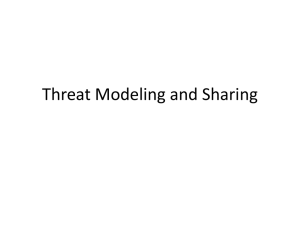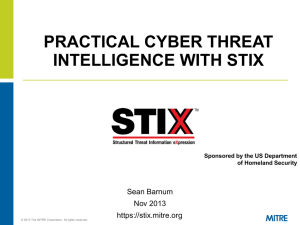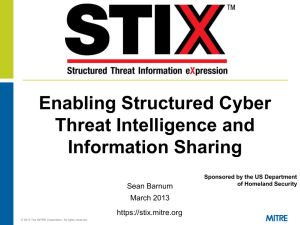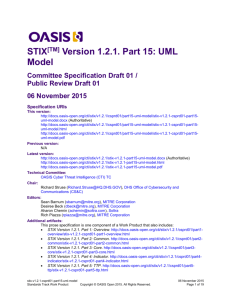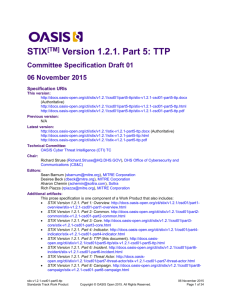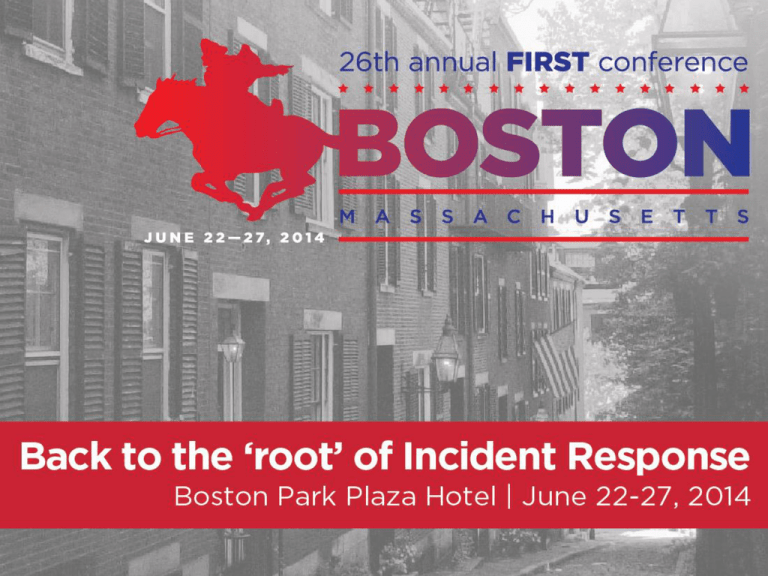
At the Speed of Data:
Automating Threat Information
to Improve Incident Response
Denise Anderson - Financial Services ISAC
George Johnson – NC4
Evolution of Cyber Security and the Cyber Intelligence
Problem
Yesterday’s Security
Today’s Problem
?
?
Tomorrow’s Solution
?
?
?
?
Network Awareness
Intelligence Sharing
Situational Awareness
Protect the perimeter and patch the holes
to keep out threats share knowledge
internally.
Identify and track threats, incorporate
knowledge and share what you know
manually to trusted others, which Is
extremely time consuming and ineffective in
raising the costs to the attackers.
Automate sharing – develop clearer picture
from all observers’ input and pro-actively
mitigate.
Increasing Cyber Risks
Manually Sharing Ineffective
Solving the Problem
• Malicious actors have become much
more sophisticated & money driven.
• Losses to US companies now in the tens
of millions; WW hundreds of millions.
• Cyber Risks are now ranked #3 overall
corporate risk on Lloyd’s 2013 Risk Index.
• Expensive because it is slow manual
process between people.
• Not all cyber intelligence is processed;
probably less than 2% overall = high risk.
• No way to enforce cyber intelligence
sharing policy = non-compliance.
• Security standards recently matured.
• Cyber Intelligence Sharing Platform
revolutionizing sharing and utilization of
threat intelligence.
3
Cyber Intelligence Problem
Typical Sharing of Intelligence Today
1.
2.
3.
4.
Machines detect threats, typically stored in proprietary formats or PDFs
People export data and manually share via multiple media types
Other people rarely get a full picture of ongoing threats
Only some threats are mitigated
4
1
Org A
2
Email/phone,
Secure portal
3
Org B
4
Impediments To Progress
• Trust
• isolated into “like” organizations based on similarly perceived
threats/business line
• Vendor Interoperability
• Individual organization with manual processes
• Many elements of automation still disconnected
• Vendor driven Collaboration across organizations
• Competitors nervous to share data
• Liability
• Disagreement about system to use to share information
• Simplicity of automation to support small organizations
• Shortage of skilled analysts
• How to share without tipping off the enemy?
5
MISSION: Sharing Timely, Relevant,
Actionable Cyber and Physical Security
Information & Analysis
A nonprofit private sector initiative formed in 1999
Designed/developed/owned by financial services
industry
Assist to mitigate recent cybercrime & fraud
activity
Process thousands of threat indicators
per month
2004: 68 members;
2014: 5,000+ members
Sharing information globally
6
FS-ISAC Operations
Information Sources
Member Communications
Treasury &
FS Regulators
FBI, USSS,
NYPD
Other Intel
Agencies
GOVERNMENT SOURCES
DHS
Information
Security
FS-ISAC 24x7
Security Operations Center
Physical
Security
Business
Continuity/
Disaster
Response
iSIGHT Partners
Info Sec
Wapack Labs
Malware
Forensics
NC4 PhySec
Incidents
MSA Phy Sec
Analysis
Cross Sector
(other ISACS)
Open Sources
(Hundreds)
Fraud
Investigations
CROSS SECTOR
SOURCES
Secunia
Vulnerabilities
Payments/
Risk
Alerts
Member Submissions
7
How FS-ISAC Works: Circles of
Trust
•
•
•
CYBER
INTEL
BRC
IRC
PRC
FSISAC
CHEF
CIC
CAC
PPSIC
Member Reports
Incident to Cyber
Intel list, or via
anonymous submission
through portal
TIC
•
•
•
•
•
•
•
•
•
•
Clearing House and Exchange Forum (CHEF)
Payments Risk Council (PRC)
Payments Processor Information Sharing Council
(PPISC)
Business Resilience Committee (BRC)
Threat Intelligence Committee (TIC)
Community Institution Council (CIC)
Insurance Risk Council (IRC)
Compliance and Audit Council (CAC)
Cyber Intelligence Listserv
Education Committee
Product and Services Review Committee
Survey Review Committee
Security Automation Working Group (SAWG)
Members respond in
real time with initial
analysis and
recommendations
SOC completes analysis,
anonymizes the source, and
generates alert to general
membership
8
Sharing is key
INFRASTRUCTURE
TRUST
To be forewarned is to be fore-armed
9
Traffic Light Protocol (TLP)
Restricted to a defined group (e.g., only
those present in a meeting.) Information
labeled RED should not be shared with
anyone outside of the group
AMBER information may be shared with
FS-ISAC members.
GREEN Information may be shared with
FS-ISAC members and partners (e.g.,
vendors, MSSPs, customers). Information
in this category is not to be shared in
public forums
WHITE information may be shared freely
and is subject to standard copyright rules
10
Other Models
• Common non-disclosure language developed and
NDA’s to enforce “secrecy”
• Consortia are built around “common interest”
areas that define a common context of threat
• Organizations operate in an open environment (no
anonymization)
• Organizations contribute what they are willing to
share in a central automated repository with
appropriate handling caveats (TLP and other)
• Participation accelerates when the percentage of
Sharing organizations is high – members share
process and technology to improve sharing for
everyone’s benefit
11
Security Automation
Will Revolutionize Information Sharing
12
Common Language(s)
• MITRE has been working
with Industry to develop
common structures
•
•
•
•
•
•
STIX
CYBOX
TAXII
CAPEC
MAEC
OVAL
• Implementations are still
immature but there is a
gathering storm…
• Analysts must have a firm
grasp of this entire space…
13
Cyber Threat Intelligence
Consider These Questions…..
What Activity are
we seeing?
What Threats
should I be
looking for and
why?
Where has this
threat been Seen?
What does it Do?
What weaknesses
does this threat
Exploit?
Why does it do
this?
Who is
responsible for
this threat?
What can I do?
14
That Machines Can Use Too
<?xml version="1.0" encoding="UTF-8"?>
<cybox:Observables xmlns:xsi="http://www.w3.org/2001/XMLSchemainstance" xmlns:cybox="http://cybox.mitre.org/cybox_v1"
xmlns:common="http://cybox.mitre.org/Common_v1"
xmlns:FileObj="http://cybox.mitre.org/objects#FileObject"
xsi:schemaLocation="http://cybox.mitre.org/cybox_v1
http://cybox.mitre.org/XMLSchema/cybox_core_v1.0(draft).xsd
http://cybox.mitre.org/objects#FileObject
http://cybox.mitre.org/XMLSchema/objects/File/File_Object_1.2.xsd"
cybox_major_version="1" cybox_minor_version="0(draft)">
<cybox:Observable>
<cybox:Stateful_Measure>
<cybox:Object id="cybox:A1" type="File">
<cybox:Defined_Object xsi:type="FileObj:FileObjectType">
<FileObj:Hashes>
<common:Hash>
<common:Type datatype="String">MD5</common:Type>
<common:Simple_Hash_Value condition="IsInSet"
value_set="4EC0027BEF4D7E1786A04D021FA8A67F,
21F0027ACF4D9017861B1D021FA8CF76,2B4D027BEF4D7E1786A04D02
1FA8CC01" datatype="hexBinary"/>
</common:Hash>
</FileObj:Hashes>
</cybox:Defined_Object>
</cybox:Object>
</cybox:Stateful_Measure>
</cybox:Observable>
</cybox:Observables>
<!-- STIX Indicator w/ Snort Example Copyright (c) 2013, The MITRE Corporation. All rights
reserved. The contents of this file are subject to the terms of the STIX License located at
http://stix.mitre.org/about/termsofuse.html. This example demonstrates a simple usage of
STIX to represent indicators with a Snort test mechanism. This demonstrates the ability of
STIX indicators to represent external test mechanisms within an indicator. It demonstrates
the use of: * STIX Indicators * STIX TestMechanisms * Extensions (Snort) * Controlled
vocabularies Created by Mark Davidson -->
<stix:STIX_Package xmlns:xsi="http://www.w3.org/2001/XMLSchema-instance"
xmlns:stix="http://stix.mitre.org/stix-1" xmlns:indicator="http://stix.mitre.org/Indicator-2"
xmlns:stixVocabs="http://stix.mitre.org/default_vocabularies-1"
xmlns:testMechSnort="http://stix.mitre.org/extensions/TestMechanism#Snort-1"
xmlns:example="http://example.com/" xsi:schemaLocation= "http://stix.mitre.org/stix-1
../stix_core.xsd http://stix.mitre.org/Indicator-2 ../indicator.xsd
http://stix.mitre.org/default_vocabularies-1 ../stix_default_vocabularies.xsd
http://stix.mitre.org/extensions/TestMechanism#Snort-1
../extensions/test_mechanism/snort.xsd" id="example:STIXPackage-0935d61b-69a4-4e648c4c-d9ce885f7fcc" version="1.0.1" >
<stix:STIX_Header>
<stix:Title>Example SNORT Indicator</stix:Title>
<stix:Package_Intent xsi:type="stixVocabs:PackageIntentVocab-1.0">Indicators - Network
Activity</stix:Package_Intent>
</stix:STIX_Header>
<stix:Indicators>
<stix:Indicator xsi:type="indicator:IndicatorType" id="example:Indicator-ad560917-6ede4abb-a4aa-994568a2abf4">
<indicator:Type xsi:type="stixVocabs:IndicatorTypeVocab-1.0">Exfiltration</indicator:Type>
<indicator:Description> Indicator that contains a SNORT signature. This snort signature
detects &apos;exfiltration attempts&apos; to the 192.168.1.0/24 subnet.
</indicator:Description> <indicator:Test_Mechanisms> <indicator:Test_Mechanism
id="example:TestMechanism-5f5fde43-ee30-4582-afaa-238a672f70b1"
xsi:type="testMechSnort:SnortTestMechanismType"> <!-- From
http://manual.snort.org/node29.html --> <testMechSnort:Rule><![CDATA[log udp any any ->
192.168.1.0/24 1:1024]]></testMechSnort:Rule> </indicator:Test_Mechanism>
</indicator:Test_Mechanisms>
</stix:Indicator> </stix:Indicators>
</stix:STIX_Package>
15
Sharing Solution
• Instead of 2% or less of attacks blocked,
detected, or prevented, a much higher percentage
of attacks are stopped
1
5
3
2
Org A
4
Intelligence
Repository
Many Trusted
Orgs
16
Current Status
• Pilot group aka “Friends and Family”
• 25 Organizations Participating
• Vision Gaining Momentum
• Live at NH-ISAC
• Working with several others
• Released Version 1.2 to the group
• Focus on “installability”
• Enabled Collaboration
• Forums, Bug Tracker, Download System
• Conversion of Open Source Intel Feeds
• Approximately 14 sources
17
Road Map
• May 12th - Avalanche 1.3
• Peer 2 Peer
• Super fast TAXII Service
• GUI Indicator Builder
• June 30th – Avalanche 1.4
• STIX Enhancements
• Trust Groups
• Peer 2 Peer changes
• July 31st – Avalanche 1.5
• Adapters
• Trust Group Changes
•
August 28th – General Availability
18
Automation Maturity
• Humans will always be in the loop
• Using STIX and TAXII repositories/gateways we can
leverage already scarce talent
• Fewer analysts will have to develop their own signatures
• Using automation it is possible to move signatures faster
• Off the shelf COTS may not interoperate across vendors
• Open Source may require in-house development to
automate information flow
• Ensuring security in information flow across systems???
Don’t let your security solution become the problem!
• But, can you trust Analysts/Incident Handlers in other
organizations?
19
What You Can Do
• Encourage Cyber Observable/Indicator sharing within your
organization
• Work within standards that are widely adopted (STIX/TAXII)
• Don’t wait for the perfect solution – start now and help
mature the process
• Engage with working and sharing groups
• Software Supply Chain Assurance
• https://buildsecurityin.us-cert.gov/
• Open Web Application Security Project
• http://www.owasp.org
• ISAC – find one that you fit
• InfraGard
• SANS/DSHIELD
20
Questions?
21
Automated Defender Sharing at
Scale
First victim
• Automated Information sharing
changes the economic balance
• Information analyzed
• Relationships created between
entities to support attribution
assertions on a larger scale
than individual organizations
• Information sharing across
Sectors/ISAC’s/consortia drives
massive economies of scale
and high cost to attackers
• Advantage – defenders as ROI
of attack diminishes forcing
faster TTP refresh, increasing
costs
22
And for Research
Blind Search Capability
• Central systems can disseminate search queries that can be locally processed
• Results are contained within the company implementation and local decisions can be
made whether to release data
23
And for Research
Rules management
• Company B allows Company A: query only
• Company C allows Company A: query only
• Company A allows All: query and collaboration
• Consortia A allows Company A: query only
• …
Company A: Port 1443 unusual long authentication connect string
• Central systems can disseminate search queries that can be locally processed
• Results are contained within the company implementation and local decisions can be
made whether to release data
24
And for Research
Portal provides Strong Identity services
or Anonymity services if needed,
collaboration services, query metadata
repository, secure file transport services,
member directories, etc… to allow for
Trust to build to increase collaboration
and speed research on threats
[Company C] Anonymous Response to query:
Let’s discuss what we can do together…
Alert! 100% match from
external query: Data marked
critical – requires director
approval for release
• Central systems can disseminate search queries that can be locally processed
• Results are contained within the company implementation and local decisions can be
made whether to release data
25
References
• TAXII: Trusted Automated eXchange of Indicator Information (http://taxii.mitre.org)
• CRITS: Collaborative Research into Threats (an implementation of TAXII – more robust
than YETI)
• YETI: An open source proof-of-concept of TAXII (https://github.com/TAXIIProject/yeti)
• STIX: Structured Threat Information eXpression (http://stix.mitre.org)
• CYBOX: Cyber Observable eXpression (http://cybox.mitre.org)
• CAPEC: Common Attack Pattern Enumeration and Classification (http://capec.mitre.org)
• MAEC: Malware Attribute Enumeration and Characterization (http://maec.mitre.org)
• CVE: Common Vulnerability Enumeration (http://cve.mitre.org)
• CWE: Common Weakness Enumeration (software typically) (http://cwe.mitre.org)
• OVAL: Open Vulnerability and Assessment Language (http://oval.mitre.org)
26

